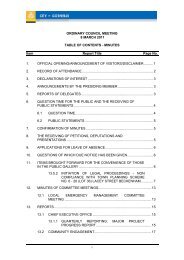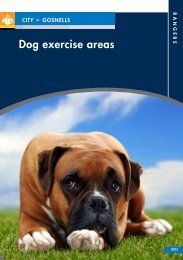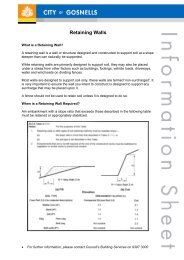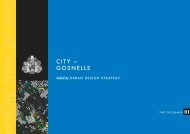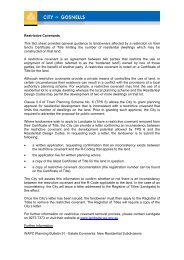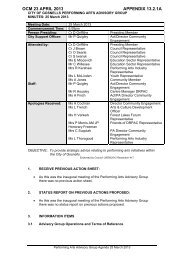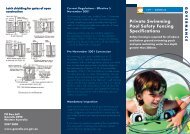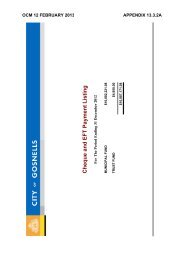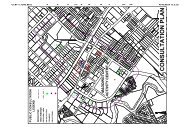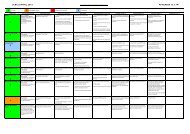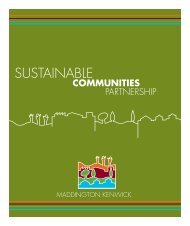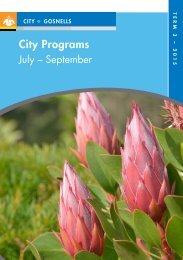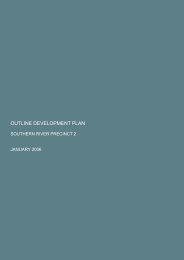Summary - City of Gosnells
Summary - City of Gosnells
Summary - City of Gosnells
Create successful ePaper yourself
Turn your PDF publications into a flip-book with our unique Google optimized e-Paper software.
Methods 27Table 3.10: Management categories <strong>of</strong> wetlands from EPA Bulletin 686 as updated in Hill et al. (1996)Management category General description Management objectiveH – High Conservation(incorporates EPA Bulletin686 categories H and C)R – Resource Enhancement(incorporates EPA Bulletin686 categories O and R)M – Multiple Use(aligned with EPA Bulletin686 category M)Wetlands which support ahigh level <strong>of</strong> attributes andfunctions.Wetlands which may havebeen partly modified butstill support substantialattributes and functions.Wetlands with fewattributes which stillprovide important wetlandfunctions.To preserve wetland attributes and functions through reservationin national parks, crown reserves and state owned land andprotection under Environmental Protection Policies.To restore wetlands through maintenance and enhancement <strong>of</strong>wetland attributes and functions by protection in crown reservesand state or local government owned land and by EnvironmentalProtection Policies or in private property by sustainablemanagement.Use, development and management should be considered in thecontext <strong>of</strong> water, town (land use) and environmental planningthrough land care.In EPA Bulletin 686, wetland basins are evaluated as isolated units (either with well-defined boundaries orwith diffuse boundaries). It is well-acknowledged that palusplains and damplands are not adequatelyevaluated by the use <strong>of</strong> Bulletin 686 (DEC, 2007) and that other methods, such as VSCRG (1998) andvegetation condition assessment, are more relevant to the assessment <strong>of</strong> these wetlands.Bulletin 686 consists <strong>of</strong> a questionnaire that includes several parts, as briefly listed below (Table 3.11).Table 3.11: Bulletin 686 Questionnaire for Wetland Management Category EvaluationPart I: Presence <strong>of</strong> Rare SpeciesIf the wetland includes gazetted rare flora or fauna species then the wetland is automatically allocated to CCW.Part II Natural AttributesPart IIA: For permanent and seasonal wetlands with well defined boundariesi. Environmental geology classification: wetlands in the Quindalup Dunes or in river/estuary floodplain receive the highestscore.ii. Adjacent wetlands. Wetlands that have no other wetlands within a 2 km radius <strong>of</strong> them receive the highest score.iii. Habitat diversity. If the composition and structure <strong>of</strong> the vegetation <strong>of</strong> the wetland under evaluation is significantly differentto that found at other nearby wetlands, the wetland receives the highest score.iv. Drought refuge. Wetlands that are major drought refuges for birds receive the highest score.v. Area <strong>of</strong> wetland. Wetlands greater the 100 ha in area receive the highest score.vi. Habitat type. Habitat types scored in this question include vegetation and landforms typical <strong>of</strong> lakes and sumplands such asfringing rushes and sedges, extensive in lake beds <strong>of</strong> rushes and sedges, large paperbark trees, islands, flooded grassland,permanent or seasonal open water, low thickets and samphires. Waterlogged areas are not considered in the scoring.vii. Emergent vegetation. Wetlands with a moderate cover (40-60%) <strong>of</strong> emergent vegetation receive the highest score comparedto very high or very low cover <strong>of</strong> vegetation as both open water and vegetation are considered desirable for waterbirds.viii. Adverse water quality. Oil slicks, algal blooms or botulism that have been observed or reported from the wetland in the lasttwo years lower the score received by the wetland.ix. Drainage. This deals with drains into and/or out <strong>of</strong> the wetland that can alter water levels or water quality. Wetlands withfewer drains entering the wetland receive the highest score as this lowers the chances <strong>of</strong> nutrient enrichment and artificialelevation <strong>of</strong> water levels. Wetlands with outlet drains constructed to maintain water levels receive the highest score, whilstoutlet drains constructed to dry out the wetland receive the lowest score.x. Adjacent nutrient scores. Wetlands with more than one nutrient source lower the score received by the wetland.xi. Area <strong>of</strong> wetland modified. Wetlands with 0-10% <strong>of</strong> area modified receive the highest score.xii. Reserve Area. The ratio <strong>of</strong> the area <strong>of</strong> wetland to the area <strong>of</strong> reserve around the wetland is considered in this question. Thelowest wetland to reserve ratio (100 ha in area receive the highest score inthe latter question.Part III: Human Use QuestionnaireWetlands that have attributes such as aesthetic values, historical and archaeological features, reserve status and community groupinvolvement and uses such as passive and active recreation, agriculture, mining or water supply receive the highest scores.Tauss, C. and Weston, A.S. (2010). The flora, vegetation and wetlands <strong>of</strong> the Maddington-Kenwick Strategic Employment Area.A survey <strong>of</strong> the rural lands in the vicinity <strong>of</strong> the Greater Brixton Street Wetlands. Report to the <strong>City</strong> <strong>of</strong> <strong>Gosnells</strong>, W.A. Version 18.04.10



